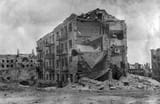>Pavlov's House (Russian: дoм Пaвлoвa tr. Dom Pavlova) was an apartment building converted into a fortified position, which Red Army defenders held for around 60 days against the Wehrmacht offensive during the Battle of Stalingrad. The siege lasted from 27 September to 25 November 1942 and eventually the Red Army managed to relieve it from the siege... Pavlov ordered the building to be surrounded with four layers of barbed wire and landmines, and set up machine-gun posts in every available window facing the square. In the early stages of the defense, Pavlov discovered that an anti-tank rifle—a PTRS-41—he had mounted on the roof was particularly effective when used to ambush unsuspecting German tanks. Once the tanks had approached to within range of the weapon, their thin turret-roof armor was exposed to AT rifle fire from above, and they were unable to elevate their weapons enough to retaliate
>For better internal communication, Pavlov's soldiers breached the walls in the basement and upper floors, and dug a communications trench to Soviet positions outside.[6] Supplies were brought in via the trench or by boats crossing the river, defying German air raids and shelling. Nevertheless, food and especially water was in short supply. Lacking beds, the soldiers tried to sleep on insulation wool torn off pipes but were subjected to harassing fire every night in order to try to break their resistance.
>The Germans attacked the building several times a day. Each time German infantry or tanks tried to cross the square and to close in on the house, Pavlov's men laid down a withering barrage of machine gun and AT rifle fire from the basement, the windows and the roof.

